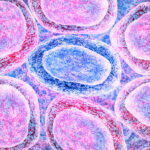Welcome to the first installment of the FAQ series here on the AllCells blog where we will answer some key questions relating to hematological tissue products.
Today, we will unpack the difference between buffy coat isolation and leukapheresis from peripheral blood. Let’s start with some definitions:
BUFFY COAT
– a cellular fraction containing platelets and white blood cells obtained from centrifugation of anticoagulated whole blood, which separates the blood components by density. It is called a buffy coat because of the yellowish color of this layer and is situated in between the plasma and erythrocyte (red blood cell) layers (Figure 1).

One key distinction between a buffy coat and peripheral blood mononuclear cells (PBMCs) is that the buffy coat contains both mononuclear (T cells, B cells, NK cells, dendritic cells and monocytes) and polymorphonuclear (granulocytes like neutrophils and eosinophils) white blood cells, while PBMCs contains only the mononuclear cell fraction.

As a side note, to enrich for PBMCs from whole blood, it is necessary to perform a density gradient separation using density media like Ficoll or Histopaque, which improves the separation resolution of different cellular fractions compared to centrifugation alone. Blood cells separate out in the following order: a top layer of plasma, followed by an opaque, white layer of PBMCs, a fraction of polymorphonuclear cells, and finally a bottom layer of erythrocytes (Figure 2).

LEUKAPHERESIS
–a specialized apheresis procedure where donor blood is circulated through an apheresis machine – at AllCells, the Spectra Optia® Apheresis System is used – that separates donor mononuclear white blood cells out for collection while returning the other blood components back to the donor’s circulation (Figure 3). Because granulocytes can affect PBMC viability, leukapheresis protocols are optimized to reduce the quantity of granulocytes in the collection process.
Whole leukapheresis tissue – or Leukopaks – are an attractive choice over buffy coat isolations from whole blood particularly for researchers requiring a large number of white blood cells from a single donor. Leukapheresis results in higher purity and significantly higher PBMC content per volume, roughly 20X higher than from buffy coat. This has the added benefit of minimizing donor variability because more experiments can be performed from a single Leukopak.
AllCells offers fresh and cryopreserved Leukopaks to meet the needs of researchers to address a variety of biological questions. Additionally, the availability of RUO and GMP Leukopak can facilitate the bilateral movement between research to clinical workflow with ease.
To learn more about Leukopaks, visit our Research Grade Leukopak product page




